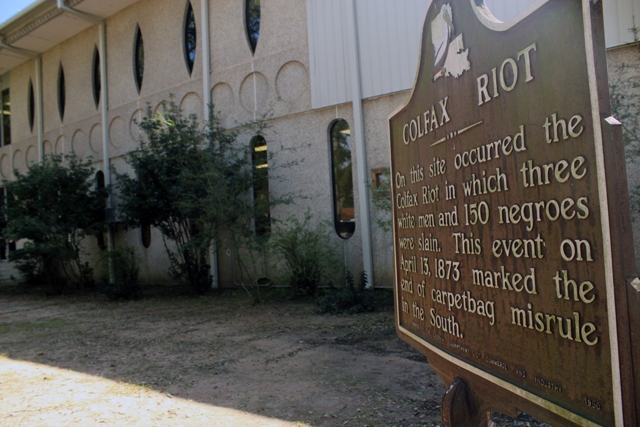
RIOT OR MASSACRE?–This Feb. 15, photo shows a historical marker near the Grant Parish Courthouse in Colfax, La. which describes a day of violence that helped condemn African Americans to a century of Jim Crow in the American South. (AP Photo/The Lafayette Daily Advertiser, Bill Decker)
by Bill Decker | The Advertiser
COLFAX, La. (AP) — A brown and silver historical marker near the Grant Parish Courthouse describes a day of violence that helped condemn African Americans to a century of Jim Crow in the American South.
What happened in Colfax 140 years ago was a massacre or a riot, depending on who you talk to. The scars of the pivotal event aren’t visible in this town of about 1,500. The community’s pride is the Pecan Festival, which begins with a blessing of the crops the first weekend of November. The old train station has been turned into a store, and the town fathers are looking for ways to bring money into town.
If Hollywood runs short of models for small-town Southern life, Colfax would do nicely.
But the town’s history includes a brutal conflict that was a defining moment in American history.
The Colfax massacre took place on April 13, 1873. It was Easter Sunday. It was, to quote the title of one of two 2009 books on the massacre, “the day freedom died.”
On that day, dozens of Black men — the number is uncertain — and three white men died in a fight for control of the parish’s first courthouse after a disputed statewide election. About half of the Black participants, and maybe more, were killed later that day after they surrendered.
“Violence was such a big part of Jim Crow,” said LeeAnna Keith, a New York City teacher who wrote “The Colfax Massacre” in 2009. “And (the massacre) was the most violent event.”
The historical marker, erected by what was then the Louisiana Department of Commerce in 1950, tells a different story. “Colfax Riot,” the marker declares. “On this site occurred the Colfax riot in which three White men and 150 Negroes were slain. This event … marked the end of carpetbag misrule in the South.”
“The history of that marker could be a book in itself,” said Charles Lane, the Washington Post reporter who wrote “The Day Freedom Died” in 2009.
The local shorthand says that if you’re White, the event was the Colfax riot. If you’re Black, it was the Colfax massacre. But that’s too easy
Glynn K. Maxwell, who is White, is the editor of The Chronicle, the weekly newspaper in Colfax. When it comes to the massacre, Maxwell believes history must be acknowledged.
“There was a riot,” Maxwell said. “There was a battle. Both sides were trying to kill each other. If you call it a massacre, you don’t give the Black people their due for standing up.”
Avery Hamilton disagrees. He’s a descendant of Jesse McKinney, one of the Black Colfax residents killed in the events surrounding the massacre.
“If you take an honest look at it, this was not a riot,” he said. “I’ll let them get away with calling it a battle. But it was like me being in the ring with Mike Tyson at his height.”